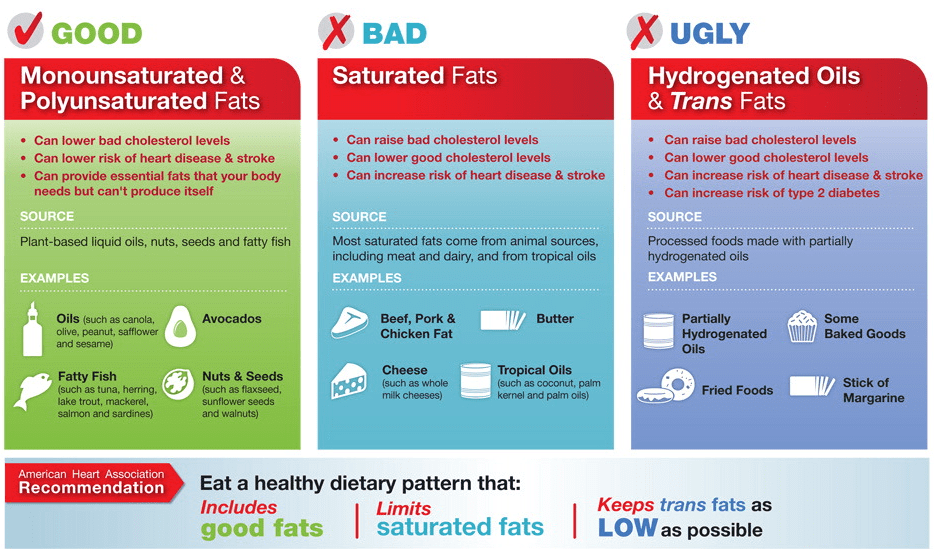Good vs. Bad fats.

Disgusting fat! Would all of our weight loss problems be solved if we just eliminated fat from our diets? The simple answer is no, it’s not that simple. Fats are an important part of a healthy diet and you cannot live without them. Essential fatty acids from certain fats are required for use to survive. Fats keep our skin soft, deliver fat-soluble vitamins, and are a great source of energy. It’s easy to get confused about good fats and bad fats so I am going to help clear the air in this article.

Fat Background:
- Unsaturated fats: These include polyunsaturated fatty acids and monounsaturated fats.
- Polyunsaturated fats are found mostly in vegetable oils and help lower both blood cholesterol levels and triglyceride levels. One type of polyunsaturated fat is omega-3 fatty acids which are heart-protective by reducing coronary artery disease.
- Monounsaturated fats reduce the risk of heart disease. These heart-healthy fats are in foods such as olives; avocados; hazelnuts; almonds; Brazil nuts; cashews; sesame seeds; pumpkin seeds; and olive, canola, and peanut oils.
- Saturated Fats: These fats are usually solid and most come from an animal source. They have been vilified in the past as being the major course of coronary after disease, but that became less clear with the identification of the risk caused by Trans Fats (an artificial fat used as a food additive – partially hydrogenated fats).

Good Fats and Bad Fats
Is there such a thing as good fat? Basically, there are two groups of fats: saturated and unsaturated. Unsaturated fats can be further divided include both polyunsaturated and monounsaturated fats. I would argue that neither type of fat is truly “bad,” but the research is clear that “good” unsaturated fat is preferred over the “bad” saturated fat.
How much fat should we eat?
The U.S. Department of Agriculture’s 2015-20 Dietary Guidelines[1] recommends that adults get 10% of their calories from saturated fats. At a minimum, we need at least 10% of our calories to come from fat to absorb fat-soluble vitamins and essential fatty acids. The source of fats should be diverse (not just from butter or eggs). Most experts agree that a realistic goal is less than 30-35% of your calories from fat.
The problem is that the typical American diet is much higher in fat and not very diverse. In most Americans, it comes primarily from cheese, butter, and other animal fats. A rough estimate is 40% of our calories come from fat. We eat so much fat because they taste so good, its flavor is fulfilling, and fats are widely available in our food supply.
Does eating fat make you fat?
Can we vilify fat as being the cause of obesity in the United States? There is no easy answer to this question and it is not that simple. Many have made the mistake, to include experts, of assuming fat is the cause of fat. Anti-fat dietitians and physicians like to use Bray from 1998 to indicate that fat is the cause of obesity[2]. Any calorie source in excess will cause obesity so I would argue that this source is too simplified. Fat is obviously part of the problem.
Obesity is more complicated than just the consumption of one macronutrient. Eating too many calories is the cause and they come from fats, carbohydrates, protein, and alcohol. Any calories you fail to burn off leads to weight gain. Genetics, age, sex, and lifestyle also weigh into the weight-gain formula , but the formula is the same. Simply put, if you exercise little and eat a diet high in calories, you are going to gain weight.
I have no doubts that fat intake plays a role in obesity. Even with my mediocre skill in mathematics, the impact of fats can be easily seen. Fat has calorie-dense with 9 calories per gram, carbohydrates and proteins have 4 calories per gram, and alcohol has 7 calories per gram. You can easily see why alcohol and fat can significantly impact your weight if you have a high intake of either.
It’s easy to overeat fats because they are found in so many foods we love. Bacon, cakes, cheese, chocolate, cookies, eggs, french fries, processed foods, sausage, and steaks all are high in fat and taste fantastic.
Clearly, eating too much of any food will expand our waistlines and fat has been proven to induce over consumption[3],[4]. If you over consume anything outside of air, fiber, and water, you are probably going to gain weight. Other studies have pointed to saturated fat as the cause of obesity[5],[6]. Yet other studies, point to processed food as the enemy[7].
More research is needed, but several things that are clear:
- Increasing waist line is tied to increase insulin resistance and difficulty losing weight[8],[9].
- Increasing unsaturated fats will reduce your risk for obesity and heart disease.
- Plant protein and fat are associated with weight loss and satiety[10].
- Low-fat diets are harder to maintain[11]. There are many studies that indicate that low-fat diets may result in an increase dieters falling off the wagon.
The bottom line: While it is tempting to choose healthier fats is better for your heart, when it comes to weight gain, all fats have about the same number of calories. And cutting the total fat in your diet not only helps you shed pounds, it can also help you live a longer and healthier life. That being said I would recommend moderation and not extreme low-fat or high-fat diets when considering weight loss. As much as you hate to hear it, moderation is still king in weight loss.
References:
- [1]“2015-2020 Dietary Guideline for Americans,” US Department of Agriculture . [Online]. Available: https://www.choosemyplate.gov
- [2]G. A. Bray and B. M. Popkin, “Dietary fat intake does affect obesity!,” The American Journal of Clinical Nutrition, pp. 1157–1173, Dec. 1998, doi: 10.1093/ajcn/68.6.1157. [Online]. Available: http://dx.doi.org/10.1093/ajcn/68.6.1157
- [3]A. Golay and E. Bobbioni, “The role of dietary fat in obesity.,” Int J Obes Relat Metab Disord, vol. 21 Suppl 3, pp. S2-11, Jun. 1997 [Online]. Available: https://www.ncbi.nlm.nih.gov/pubmed/9225171
- [4]L. H. Epstein, C. C. Gordy, H. A. Raynor, M. Beddome, C. K. Kilanowski, and R. Paluch, “Increasing Fruit and Vegetable Intake and Decreasing Fat and Sugar Intake in Families at Risk for Childhood Obesity,” Obesity Research, pp. 171–178, Mar. 2001, doi: 10.1038/oby.2001.18. [Online]. Available: http://dx.doi.org/10.1038/oby.2001.18
- [5]C. M. Phillips et al., “High Dietary Saturated Fat Intake Accentuates Obesity Risk Associated with the Fat Mass and Obesity–Associated Gene in Adults,” The Journal of Nutrition, pp. 824–831, Mar. 2012, doi: 10.3945/jn.111.153460. [Online]. Available: http://dx.doi.org/10.3945/jn.111.153460
- [6]W. L. Holland et al., “Inhibition of Ceramide Synthesis Ameliorates Glucocorticoid-, Saturated-Fat-, and Obesity-Induced Insulin Resistance,” Cell Metabolism, pp. 167–179, Mar. 2007, doi: 10.1016/j.cmet.2007.01.002. [Online]. Available: http://dx.doi.org/10.1016/j.cmet.2007.01.002
- [7]E. H. Zobel, T. W. Hansen, P. Rossing, and B. J. von Scholten, “Global Changes in Food Supply and the Obesity Epidemic,” Curr Obes Rep, pp. 449–455, Sep. 2016, doi: 10.1007/s13679-016-0233-8. [Online]. Available: http://dx.doi.org/10.1007/s13679-016-0233-8
- [8]J. Jepsen and H. Rasmussen, “The metabolic syndrome among Danish seafarers: a follow-up study.,” Int Marit Health, vol. 67, no. 3, pp. 129–36, Jan. 2016, doi: 10.5603/IMH.2016.0025. [Online]. Available: https://www.ncbi.nlm.nih.gov/pubmed/27681211
- [9]J. Després and I. Lemieux, “Abdominal obesity and metabolic syndrome.,” Nature, vol. 444, no. 7121, pp. 881–7, Dec. 2006, doi: 10.1038/nature05488. [Online]. Available: https://www.ncbi.nlm.nih.gov/pubmed/17167477
- [10]J.-P. Després and I. Lemieux, “Abdominal obesity and metabolic syndrome,” Nature, pp. 881–887, Dec. 2006, doi: 10.1038/nature05488. [Online]. Available: http://dx.doi.org/10.1038/nature05488
- [11]C. Walsh, C. Ebbeling, J. Swain, R. Markowitz, H. Feldman, and D. Ludwig, “Effects of diet composition on postprandial energy availability during weight loss maintenance.,” PLoS One, vol. 8, no. 3, p. e58172, Jan. 2013, doi: 10.1371/journal.pone.0058172. [Online]. Available: https://www.ncbi.nlm.nih.gov/pubmed/23483989







Be the first to comment on "Healthy vs. Unhealthy Fats and Weight Loss"